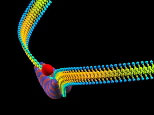MIT
researchers led by Professor Sidney Yip have proposed a new theory that might eliminate the limited speed and control of present day artificial muscles.
Currently, robotic muscles move 100 times slower than ours. But potentially, engineers applying the Yip lab's new theory could boost those speeds -- making robotic muscles 1,000 times faster than human muscles -- with virtually no extra energy demands and the added bonus of a simpler design.
In the past few years, engineers have made artificial muscles that actuate, or drive, robotic devices from conjugated polymers.
"Conjugated polymers are also called conducting polymers because they can carry an electric current, just like a metal wire," says Xi Lin, a postdoctoral associate in Yip's lab, whereas conventional polymers like rubber and plastic are insulators and do not conduct electricity.
And these conjugated polymers can actuate on command if charges can be sent to specific locations in the polymer chain in the form of "solitons" (charge density waves). Solitons are highly mobile charge carriers that exist because of the special nature (the one-dimensional chain character) of the polymer.
Scientists already knew that solitons enabled the conducting polymers to conduct electricity. But until now, scientists, hampered by not knowing the mechanism, have been making conducting polymers in a roundabout way, by bathing (doping) the materials with ions that expand the volume of the polymer. That expansion was thought to give the polymers their strength, but it also makes them heavy and slow.
Lin discovered, though, that adding the ions is unnecessary, because theoretically, shining a light of a particular frequency on the conducting polymer can activate the soliton. Without the extra weight of the added ions, the polymers could bend and flex much more quickly. And that rapid-fire motion gives rise to the high-speed actuation, - that is, the ability to activate a device.

As can be seen in the figure above, light of a specific frequency is shone on the conducting polymer. The polymer in this image is a chain (neutral charge, green) that is naturally curved before exposure. The effect of the light is to create positive charges (red) in a localised area. The positive charges enhance the chemical bonding between the polymer’s units and straighten out the curved chain in that area. The straightening occurs where the red and blue striped lobe appeared in image above. The lobe can move along the polymer chain rapidly.
To arrive at these conclusions, Lin worked from fundamental principles to understand the physical mechanisms governing conjugated polymers, rather than using experimental data to develop hypotheses about how they worked. He started with Schrödinger's equation, a hallmark of quantum mechanics that describes how a single electron behaves (its wave function). But solving the problem of how a long chain of electrons behaves was another matter, requiring long and complex analyses.




Poll: Should the UK’s railways be renationalised?
Rail passenger numbers declined from 1.27 million in 1946 to 735,000 in 1994 a fall of 42% over 49 years. In 2019 the last pre-Covid year the number...